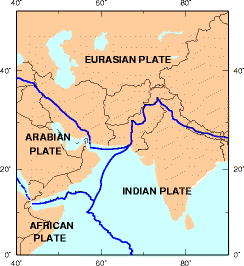Iranian Plateau

The Persian plateau[1][2] is a geological formation in Southwest Asia. It is the part of the Eurasian Plate wedged between the Arabian and Indian plates, situated between the Zagros mountains to the west, the Caspian Sea and the Kopet Dag to the north, the Hormuz Strait and Persian gulf to the south and Indus River to the east.
As a historical region, it includes Parthia, Media and eastern Persia, the heartlands of Greater Iran (mainly Iran, Afghanistan and Baluchestan).[3] The Zagros mountains form the plateau's western boundary, and its eastern slopes may be included in the term. The Encyclopedia Britannica excludes "lowland Khuzestan" explicitly[4] and characterizes Elam as spanning "the region from the Mesopotamian plain to the Iranian Plateau".[5]
From the Caspian in the northwest to Baluchistan in the south-east, the Iranian Plateau extends for close to 2,000 km. It encompasses the greater part of Iran, Afghanistan and Baluchestan, on an area roughly outlined by the quadrangle formed by the cities of Tabriz, Shiraz, Peshawar and Quetta containing some 3,700,000 square kilometres (1,400,000 sq mi). In spite of being called a "plateau", it is far from flat but contains several mountain ranges, the highest peak being Damavand in the Alborz at 5610 m, and the Lut basin east of Kerman in Central Iran falling below 300 m.
Geology
In geology, the plateau region of Iran primarily formed of the accretionary Gondwanan terranes between the Turan platform to the north and the Main Zagros Thrust, the suture zone between the northward moving Arabian plate and the Eurasian continent, is called the Iranian plateau. It is a geologically well-studied area because of general interest in continental collision zones, and because of Iran's long history of research in geology, particularly in economic geology (although Iran's major petroleum reserves are not in the plateau).
Geography
The Persian plateau in geology refers to a geographical area north of the great folded mountain belts resulting from the collision of the Arabian plate with the Eurasian plate. In this definition, the Iranian plateau does not cover southwestern Iran. It extends from East Azerbaijan Province in northwest of Iran (Persia) to southern Afghanistan and Baluchestan. It also includes smaller parts of the Republic of Azerbaijan and Turkmenistan.
Its mountain ranges can be divided into five major sub-regions:[6] Northwestern Iranian Plateau where the Pontus and Taurus mountains converage, is rugged country with higher elevations, a more severe climate, and greater precipitation than are found on the Anatolian Plateau. The region is known as the Anti-Taurus, and the average elevation of its peaks exceeds 3,000 m. Mount Ararat, at 5,137 meters (16,854 ft) the highest point in Turkey, is located in the Anti-Taurus. Lake Van is situated in the mountains at an elevation of 1,546 meters (5,072 ft).
The headwaters of three major rivers arise in the Anti-Taurus: the east-flowing Aras River, which empties into the Caspian Sea; the south-flowing Euphrates and Tigris join in Iraq before emptying into the Persian Gulf. Several small streams that empty into the Black Sea or landlocked Lake Van also originate in these mountains.
Southeast Anatolia lies south of the Anti-Taurus Mountains. It is a region of rolling hills and a broad plateau surface that extends into Syria. Elevations decrease gradually, from about 800 meters (2,600 ft) in the north to about 500 meters (1,600 ft) in the south. Traditionally, wheat and barley are the main crops of the region.
Mountain ranges
- Northwest Iran Ranges
- Sabalan 4,811 m (15,784 ft)
- Alborz
- Damavand 5,610 m (18,410 ft)
- Central Iranian Plateau
- Kūh-e Hazār 4,500 m (14,800 ft)
- Kuh-e Jebal Barez
- Eastern Iranian Ranges
- Kopet Dag
- Kuh-e Siah Khvani 3,314 m (10,873 ft) 36°17′N 59°3′E / 36.283°N 59.050°E
- Eshdeger Range
- 2,920 m (9,580 ft) 33°32′N 57°14′E / 33.533°N 57.233°E
- Kopet Dag
- Baluchestan
- Sikaram 4,755 m (15,600 ft) 34°2′N 69°54′E / 34.033°N 69.900°E
- Kuh-e Taftan 3,941 m (12,930 ft) 28°36′N 61°8′E / 28.600°N 61.133°E
- Zargun 3,578 m (11,739 ft) 30°16′N 67°18′E / 30.267°N 67.300°E
Rivers and plains
History
In the Bronze Age, Elam stretched across the Zagros mountains, connecting Mesopotamia and the Iranian Plateau. The kingdoms of Aratta known from cuneiform sources may have been located in the Central Iranian Plateau.
In classical antquity the region was known as Persia, due to the Persian Achaemenid dynasty, originating in Persia proper, or Fars.
The Middle Persian Erān (whence Modern Persian Irān) began to be used in reference to the state (rather than as an ethnic designator) from the Sassanid period (see Etymology of Iran).
Archaeology
Archaeological sites and cultures of the Iranian plateau include:
- Central Iranian Plateau ("Jiroft culture")
- Zayandeh River Civilization
- Tappeh Sialk
- Paleolithic sites
See also
References
- ^ Robert H. Dyson. The archaeological evidence of the second millennium B.C. on the Persian plateau. ISBN 0521070988.
- ^ James Bell (1832). A System of Geography, Popular and Scientific. Archibald Fullarton. pp. 7, 284, 287, 288.
- ^ Old Iranian Online, University of Texas College of Liberal Arts (retrieved 10 February 2007)
- ^ s.v. "ancient Iran"
- ^ s.v. "Elamite language"
- ^ "Iranian Plateau". Peakbagger.com.
- Y. Majidzadeh, Sialk III and the Pottery Sequence at Tepe Ghabristan. The Coherence of the Cultures of the Central Iranian Plateau, Iran 19, 1981, 141-46.
External links
- "Central Iranian Plateau". Peakbagger.com.
- Yazd basin

